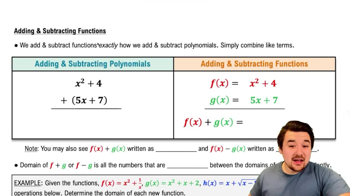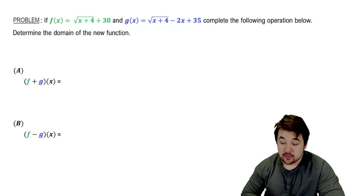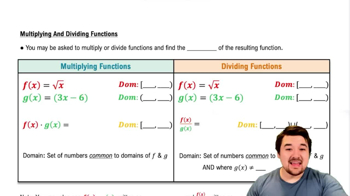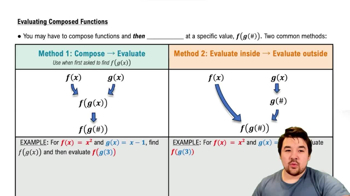Table of contents
- 0. Functions7h 52m
- Introduction to Functions16m
- Piecewise Functions10m
- Properties of Functions9m
- Common Functions1h 8m
- Transformations5m
- Combining Functions27m
- Exponent rules32m
- Exponential Functions28m
- Logarithmic Functions24m
- Properties of Logarithms34m
- Exponential & Logarithmic Equations35m
- Introduction to Trigonometric Functions38m
- Graphs of Trigonometric Functions44m
- Trigonometric Identities47m
- Inverse Trigonometric Functions48m
- 1. Limits and Continuity2h 2m
- 2. Intro to Derivatives1h 33m
- 3. Techniques of Differentiation3h 18m
- 4. Applications of Derivatives2h 38m
- 5. Graphical Applications of Derivatives6h 2m
- 6. Derivatives of Inverse, Exponential, & Logarithmic Functions2h 37m
- 7. Antiderivatives & Indefinite Integrals1h 26m
- 8. Definite Integrals3h 25m
0. Functions
Combining Functions
Problem 1.96c
Textbook Question
Inverse of composite functions
c. Explain why if g and h are one-to-one, the inverse of ƒ(x) = g(h(x)) exists.
 Verified step by step guidance
Verified step by step guidance1
Recall that a function is one-to-one (injective) if it never assigns the same value to two different domain elements. This means that for functions g and h, if g(a) = g(b), then a must equal b, and similarly for h.
Understand that the composition of two one-to-one functions, ƒ(x) = g(h(x)), will also be one-to-one. This is because if g(h(a)) = g(h(b)), then h(a) must equal h(b) (since g is one-to-one), and consequently, a must equal b (since h is also one-to-one).
Since ƒ(x) is one-to-one, it has an inverse function, denoted as ƒ⁻¹(y), which will map each output back to a unique input.
To find the inverse of the composite function, we can express it as y = g(h(x)). To find the inverse, we will first solve for h(x) in terms of y, and then solve for x in terms of h⁻¹(y).
Finally, we conclude that the existence of the inverses g⁻¹ and h⁻¹ allows us to express the inverse of the composite function as ƒ⁻¹(y) = h⁻¹(g⁻¹(y)), confirming that the inverse of ƒ(x) exists.
Recommended similar problem, with video answer:
 Verified Solution
Verified SolutionThis video solution was recommended by our tutors as helpful for the problem above
Video duration:
4mPlay a video:
Was this helpful?

 5:56m
5:56mWatch next
Master Adding & Subtracting Functions with a bite sized video explanation from Nick
Start learning




